Different Types of Impacted Wisdom Teeth: Classification and Treatment
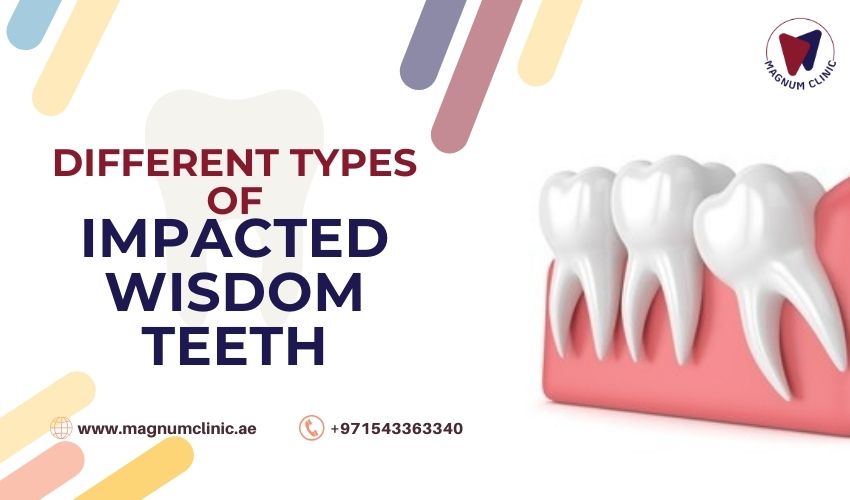
Wisdom teeth, the third molars are often associated with newfound maturity and knowledge. However, these can cause quite a stir when they decide to make an appearance. These late bloomers can be a painful and perplexing experience for many people. But fear not! In this article, we embark on a journey to demystify the world of impacted wisdom teeth. It involves exploring different types of Impacted Wisdom teeth, and their classification. Also, it covers the most recommended treatments for impacted wisdom teeth. So, let’s read about the third molar impaction and save the day (and your smile!).
Why Do Wisdom Teeth Get Impacted?
Impacted wisdom teeth occur when there isn’t enough space in the jaw for them to erupt properly. This can lead to various dental issues, including pain, infection, and damage to neighboring teeth. Here's a concise list outlining why wisdom teeth get impacted:
- Lack of Space: Modern diets have led to smaller jaws, leaving insufficient room for wisdom teeth to grow properly.
- Improper Angle: Wisdom teeth can grow at angles, such as horizontally or diagonally, making it difficult for them to emerge through the gums.
- Obstructions: Nearby teeth or bone tissue can obstruct the pathway, preventing wisdom teeth from erupting normally.
- Delayed Eruption: Wisdom teeth typically emerge between ages 17 and 25; delays in this process can cause impaction.
- Genetic Factors: Family history of impacted wisdom teeth increases the likelihood of experiencing similar issues.
- Abnormal Growth: Wisdom teeth can develop in unusual shapes or sizes, hindering their normal eruption.
- Gum Disease: Infections and gum disease can lead to inflammation, making it challenging for wisdom teeth to emerge properly.
Read Also: Ideal Age For Wisdom Tooth Extraction
Different Types of Impacted Wisdom Teeth
Understanding the different types of impacted wisdom teeth is crucial for effective treatment. Here are the common types of wisdom tooth impaction that you must know about.
1. Vertical Impaction
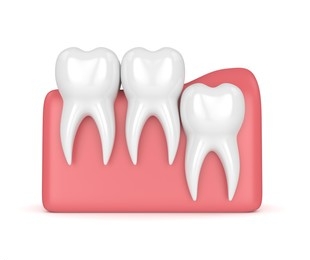
In a vertical impaction, the wisdom tooth is partially erupted and grows straight up, but it doesn’t have enough space to fully emerge from the gum line. This type of impaction can cause pain and discomfort and often requires extraction.
2. Mesial Impaction
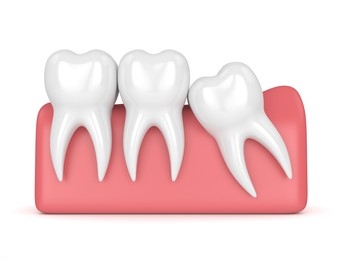
A mesial impaction happens when the wisdom tooth grows at an angle facing the front of the mouth, toward the second molar. This can cause the wisdom tooth to push against the adjacent tooth, leading to pain, swelling, and potential damage to the second molar. Extraction is typically necessary for mesially impacted wisdom teeth.
3. Distal Impaction
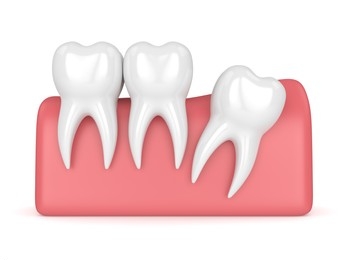
A distal impaction occurs when the wisdom tooth is angled toward the back of the mouth, away from the second molar. This type of impaction can also cause pain and discomfort and may require extraction if it leads to problems with the neighboring teeth or causes pain.
4.Horizontal Impaction
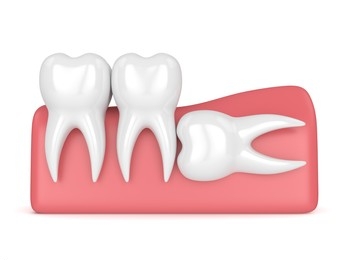
Horizontal impaction happens when the wisdom tooth grows sideways, parallel to the gum line. This type of impaction can be extremely painful and may cause damage to the adjacent teeth. Surgical extraction is often necessary for horizontally impacted wisdom teeth.
5. Soft Tissue Impaction
In a soft tissue impaction, the wisdom tooth has partially erupted through the gum tissue but not the underlying bone. This situation can create a flap of gum tissue that easily traps food particles, leading to infection and inflammation. Extraction is usually recommended for soft tissue impacted wisdom teeth.
6. Bony Impaction
Bony impaction occurs when the wisdom tooth is fully encased in the jawbone. The tooth remains completely below the gum line and is surrounded by dense bone tissue. Bony impactions often require surgical extraction due to the complexity of the procedure.
The Classification of Wisdom Tooth Impaction
Dentists use a classification system to categorize the position of impacted wisdom teeth. The classification helps dentists plan the appropriate treatment strategy. Here's a concise breakdown of the classification of wisdom tooth impactions:
- Class I Impaction: Partially covered by gum tissue but in a normal position; can often be extracted with a simple procedure.
- Class II Impaction: Partially covered and tilted at an abnormal angle; requires a more complex surgical extraction.
- Class III Impaction: Fully encased in the jawbone, partially covered by gum tissue; requires surgical extraction involving removal of jawbone.
- Class IV Impaction: Completely encased in the jawbone and fully covered by gum tissue; the most complex type, requiring extensive surgical procedure for extraction.
Read Also: Importance Of Wisdom Tooth Removal
Treatment Options For Wisdom Tooth Impaction
There are effective treatments for impacted third molars which are tailored to the type and severity of wisdom tooth impaction. Here is the list.
1. Extraction
Extraction is the most common treatment for impacted wisdom teeth. Oral surgeons carefully remove the tooth, ensuring minimal discomfort and a swift recovery. Modern techniques and anesthesia options make the procedure much more comfortable than you might expect.
2. Surgical Extraction
In cases of complex impactions, surgical extraction might be necessary. Oral surgeons utilize advanced techniques to remove deeply impacted teeth, ensuring a smooth procedure and speedy recovery.
3.Pain Management
Post-extraction, pain management is vital. Dentists prescribe pain relievers and recommend cold compresses to alleviate swelling, ensuring you can resume your daily activities in no time.
4. Preventive Care
Regular dental check-ups are essential to monitor the growth of wisdom teeth. Dentists can detect potential issues early, allowing for proactive measures and preventing complications.
Conclusion
While dealing with impacted wisdom teeth might seem daunting, understanding the types, classifications, and available treatments can turn this dental dilemma into a manageable situation. Moreover, it's crucial to consult with a dentist or oral surgeon to determine the best treatment approach based on the type and position of the impacted wisdom tooth. Early intervention and appropriate care can prevent complications and promote oral health.
Frequently Asked Questions (FAQs) about Wisdom Tooth Impaction
How long does it take to recover after wisdom tooth extraction?
Recovery usually takes about 1-2 weeks. Patients are typically back to their regular activities within a few days, but full healing of the gum tissue may take a bit longer.
What foods can I eat after wisdom tooth extraction?
Soft, easy-to-chew foods like soups, yogurt, mashed potatoes, and smoothies are recommended during the initial days post-extraction. Avoid hot, spicy, and crunchy foods.
What are the symptoms of a wisdom tooth impaction?
Here are the common symptoms of wisdom tooth impaction
1. Pain and Discomfort
Dull, aching pain in the back of the mouth or jaw, especially while chewing or biting down.
2. Swelling and Tenderness
Swelling of the gums in the back of the mouth, often accompanied by tenderness and redness.
3. Difficulty Opening Mouth
Limited ability to open the mouth fully, which can make eating and talking uncomfortable.
4. Unpleasant Taste or Bad Breath
Foul taste in the mouth or persistent bad breath, which can be caused by the accumulation of food particles around the impacted tooth.
5.Headaches and Earaches
Pain to the temples, ears, or throat, leading to headaches and earaches.
6. Jaw Stiffness
Stiffness or pain in the jaw joint (temporomandibular joint) due to inflammation around the impacted tooth.
7.Swollen Lymph Nodes
Swelling and tenderness in the lymph nodes of the neck and jaw area due to the body's response to the infection or inflammation.
8. Difficulty in Brushing and Flossing
Difficulty in cleaning the area around the impacted tooth, leading to plaque accumulation, gum disease, and tooth decay.
9. Cysts or Tumors
In rare cases, the presence of an impacted wisdom tooth can lead to the formation of cysts or tumors around the impacted area, causing swelling and discomfort.
